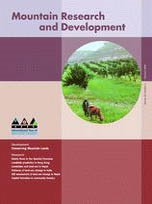Dear Readers,
This issue of Mountain Research and Development is the first in the International Year of Mountains (IYM2002). The basic purpose of IYM2002, as declared by the UN General Assembly, is “to promote the conservation and sustainable development of mountain regions, thereby ensuring the well-being of mountain and lowland communities.”
In order to achieve this purpose, natural resources in mountain regions need to be used in a sustainable way that avoids overuse and degradation. The Global Assessment of Soil Degradation (GLASOD) published by the United Nations Environment Programme (UNEP) and the International Soil Reference and Information Centre (ISRIC) in 1990 showed that one-fourth of the world's agricultural land—corresponding to one-tenth of the Earth's land area—has been damaged by long-term soil degradation owing primarily to water and wind erosion. Although there has been no update of this global assessment, the issue of land and soil degradation has been included in several global agendas and formal frameworks.
Mountains are particularly susceptible to soil erosion caused by surface runoff due to high rainfall, steep slopes with erodible soils, growing pressure to use marginal lands for agriculture in some areas, abandonment of agropastoral land in other areas, and the construction of infrastructure for economic activities. Because mountains also serve as water towers, providing water not only in mountain areas but for the surrounding lowlands as well, land degradation in mountains has serious impacts on the global supply of fresh water and on growing water-related conflicts.
The present issue focuses on efforts to avoid and combat land degradation; experiences need to be documented and exchanged so that existing knowledge can be used for better land management. Hence the development section presents examples of successful soil and water management, focusing on revival of a degraded region in Serbia, agrodiversity in Thailand, contour bunds and hedgerows in the Philippines, live fences to protect sloping lands in Ecuador, and spring sanctuaries in the Indian Himalaya. An article on the World Overview of Conservation Approaches and Technologies (WOCAT), a knowledge management system in which over 35 institutions worldwide collaborate, illustrates tools that can be used to document and exchange local experiences at the global level. Articles in the research section demonstrate the wealth of knowledge about land use, land cover change, resource management in mountain areas, and the potential for improved use of resources.
Additional efforts are needed at the local, national and global levels to raise awareness of the possibilities of reducing land degradation, showing the potential for improved land management in mountains regions as well as the impact of successful management techniques on the livelihoods of people in the mountains and the surrounding lowlands. This will be a significant contribution to the overall purpose of IYM2002.
Hanspeter Liniger and Gudrun Schwilch, CDE,
Guest Editors of the Development Section





